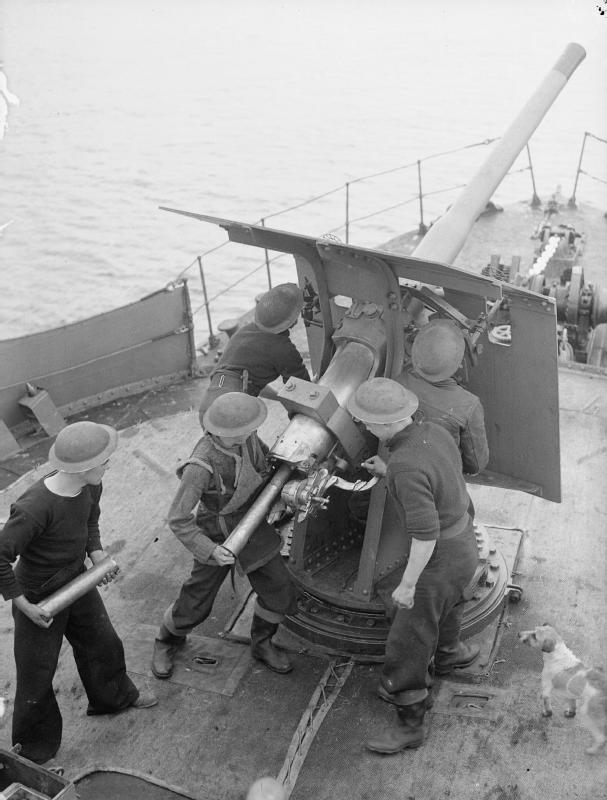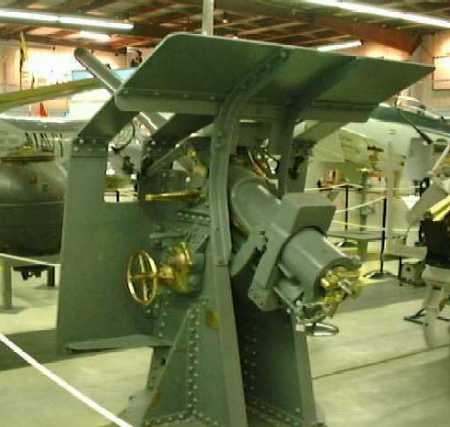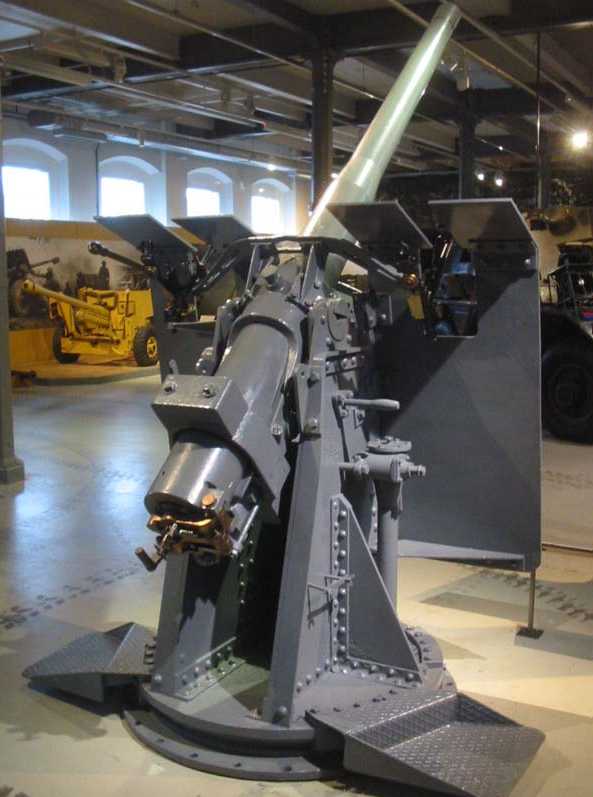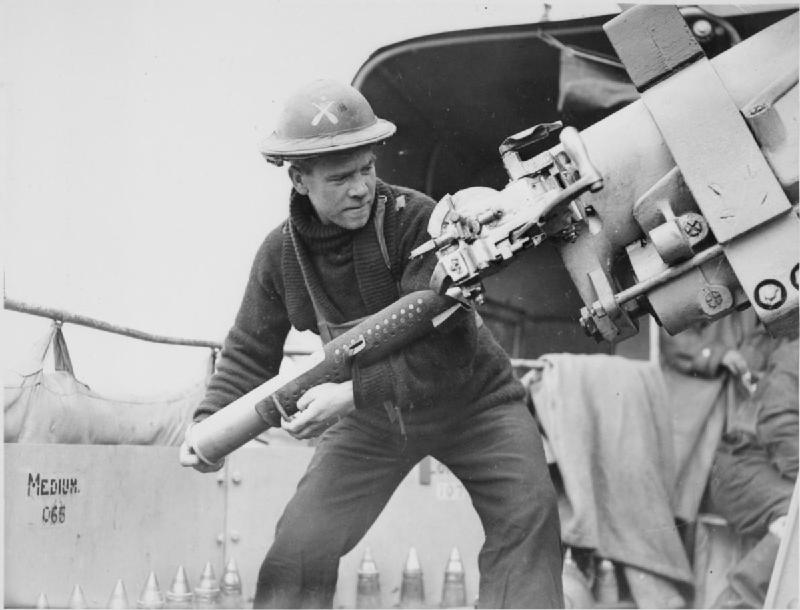
First used on the "27-knot" destroyers of the 1890s. Many small warships still carried these old guns during World War II and they were also used in coastal defense batteries.
The Mark I was a fairly complicated design of A tube, B tube, jacket and C hoop shrunk over the B tube/jacket join. The Mark II was a First World War gun with a combined B tube and jacket while the Mark V was produced during the Second World War and had a monobloc barrel. Some 4,737 Mark I and IIs were built along with an additional 3,494 Mark Vs. Canada also built over 1,000 of these weapons, which were referred to as the "Ogden 3-inch" as they were manufactured at the Canadian Pacific Railway's Ogden shops in Calgary.
The Japanese guns were originally purchased directly from Elswick and Vickers but later ones were license-built copies. These guns were similar to or virtually identical to the British Mark I. Used as anti-torpedo boat guns on larger warships. Redesignated as 41st Year Type on 25 December 1908. Redesignated in centimeters on 5 October 1917. Although finally classified as 8 cm, the bore remained 3.0" (7.62 cm).
Early Italian guns were purchased from Elswick. Nearly all of the later ones were built by Ansaldo under license to a design provided by Armstrong during World War I or to a modified design for anti-aircraft mountings. After World War I, these guns were used afloat mainly on older warships and auxiliaries. About 730 guns were used for the anti-aircraft defense of Italy during World War II.
The data that follows is for the British version except where noted.
| Designation | Britain: 12-pdr [3"/40 (76.2 cm)] 12cwt QF HA Marks I, II, V and AV 1 Japan:
Italy:
|
|---|---|
| Ship Class Used On | Britain: 27-knot destroyers of the 1890s, World War I destroyers, RFAs and DEMs of World War II
Japan: Most warships built between 1890 and 1920, Russian warships captured during Russo-Japanese War Italy: Minor warships and auxiliaries of World War II |
| Date Of Design | about 1893 |
| Date In Service | 1894 |
| Gun Weight | 0.6 tons (510 kg) |
| Gun Length oa | 123.6 in (3.139 m) |
| Bore Length | 120.0 in (3.048 m) |
| Rifling Length | 103.0 in (2.617 m) |
| Grooves | (16) 0.0375 in deep x 0.365 (0.953 x 9.27 mm) |
| Lands | 0.224 in (5.69 mm) |
| Twist | Uniform RH 1 in 30 2 |
| Chamber Volume | 121.7 in3 (1.994 dm3) |
| Rate Of Fire | 15 rounds per minute |
| Type | Britain and Japan: Separate
Italy: Fixed |
|---|---|
| Projectile Types and Weights | Britain
HE - 12.9 lbs. (5.87 kg) Japan
Italy
|
| Bursting Charge | N/A |
| Projectile Length | N/A |
| Propellant Charge | 2.09 lbs. (0.95 kg) SC061 or 2.75 lbs. (1.25 kg) NF059
Cartridge - Up to 9.5 lbs. (4.3 kg) with propellant |
| Muzzle Velocity | Britain - 2,235 fps (681 mps)
Japan - 2,231 fps (680 mps) Italy
|
| Working Pressure | 16 in2 (2,520 kg/cm2) |
| Approximate Barrel Life | 2,700 rounds |
| Ammunition stowage per gun | N/A 1a |
- ^Outfits for most Britain ships were SAP, CP, HE, shrapnel and star shell. Submarine outfits were HE and star shell. Flashless charges were supplied late during World War II.
| Elevation | Distance |
|---|---|
| 40 degrees | 11,750 yards (10,740 m) |
| AA Range @ 70 degrees | 19,000 feet (5,790 m) |
| Elevation | Distance |
|---|---|
| 42 degrees | 10,940 yards (10,000 m) |
| Designation | Britain 12cwt Mounting
PI and PI* 1b HA VIII and HA VIII* 2b HA/LA IX, HA/LA IX* and HA/LA IX** Japan: N/A Italy
|
|---|---|
| Weight | PI*: 1.233 tons (1,253 kg)
HA VIII: 2.10 tons (2,134 kg) HA/LA IX: 2.45 tons (2,489 kg) |
| Elevation | Britain
PI*: -10 / +30 degrees HA VIII: -10 / +90 degrees HA/LA IX: -10 / +70 degrees Japan
Italy:
|
| Elevation Rate 3b | Manually operated, only |
| Train | 360 degrees |
| Train Rate 3b | Manually operated, only |
| Gun recoil | 9.6 - 10 in (24 - 25 cm) |




"Naval Weapons of World War Two" and "The Battle of Tsu-Shima" articles in "Warship Volume II" all by John Campbell
"Warships of the Imperial Japanese Navy, 1869-1945" by Hansgeorg Jentschura, Dieter Jung and Peter Mickel
---
US Naval Technical Mission to Japan report O-19: Japanese Projectiles General Types
US Naval Technical Mission to Japan report O-54(N): Japanese Naval Guns
21 November 2006 - Benchmark
29 August 2011 - Corrected typographical error
15 December 2013 - Added Additional Pictures Page
05 February 2022 - Converted to HTML 5 format, added use on Russian warships captured by Japan, updated link to Naval Museum of Alberta
